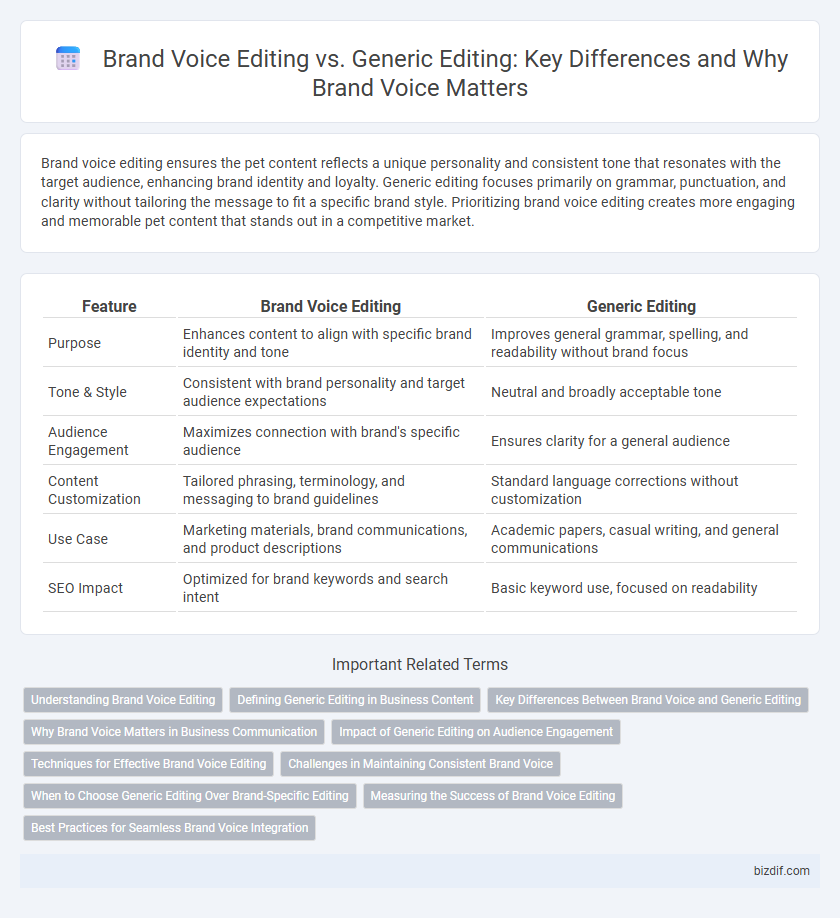Brand voice editing ensures the pet content reflects a unique personality and consistent tone that resonates with the target audience, enhancing brand identity and loyalty. Generic editing focuses primarily on grammar, punctuation, and clarity without tailoring the message to fit a specific brand style. Prioritizing brand voice editing creates more engaging and memorable pet content that stands out in a competitive market.
Table of Comparison
| Feature | Brand Voice Editing | Generic Editing |
|---|---|---|
| Purpose | Enhances content to align with specific brand identity and tone | Improves general grammar, spelling, and readability without brand focus |
| Tone & Style | Consistent with brand personality and target audience expectations | Neutral and broadly acceptable tone |
| Audience Engagement | Maximizes connection with brand's specific audience | Ensures clarity for a general audience |
| Content Customization | Tailored phrasing, terminology, and messaging to brand guidelines | Standard language corrections without customization |
| Use Case | Marketing materials, brand communications, and product descriptions | Academic papers, casual writing, and general communications |
| SEO Impact | Optimized for brand keywords and search intent | Basic keyword use, focused on readability |
Understanding Brand Voice Editing
Brand voice editing ensures consistency in tone, style, and messaging across all content, reflecting the unique personality and values of a company. Unlike generic editing, which focuses solely on grammar, punctuation, and clarity, brand voice editing tailors language to resonate with the target audience and reinforce brand identity. This specialized editing approach enhances brand recognition and builds trust through a distinct, authentic communication style.
Defining Generic Editing in Business Content
Generic editing in business content involves refining text for clarity, grammar, punctuation, and consistency without altering the original brand tone or messaging. It focuses on improving readability and correcting errors to ensure professionalism and accuracy across various business documents. This approach serves as a foundational step before applying specialized brand voice editing tailored to the unique identity of a company.
Key Differences Between Brand Voice and Generic Editing
Brand Voice Editing tailors content to reflect a specific brand's unique personality, tone, and values, ensuring consistency across all communications. Generic Editing focuses primarily on correcting grammar, spelling, and syntax without emphasizing the preservation of a distinct voice. Key differences include Brand Voice Editing's alignment with brand identity and audience engagement, whereas Generic Editing prioritizes general clarity and correctness.
Why Brand Voice Matters in Business Communication
Brand voice editing ensures consistency in tone and style that resonates with the target audience, strengthening brand identity across all communication channels. Unlike generic editing, which focuses solely on grammar and clarity, brand voice editing aligns messaging with company values and personality, enhancing customer trust and engagement. This tailored approach drives brand recognition and loyalty, making it essential for effective business communication.
Impact of Generic Editing on Audience Engagement
Generic editing often strips content of its unique brand voice, resulting in a bland and less memorable message that fails to resonate deeply with the target audience. This lack of personalization can diminish audience engagement, as readers are less likely to connect emotionally or develop loyalty to content that feels impersonal or generic. Maintaining a distinct brand voice through specialized editing strengthens audience trust and fosters a more meaningful interaction with the content.
Techniques for Effective Brand Voice Editing
Brand voice editing demands techniques that emphasize consistency in tone, style, and language to align content with a company's identity, often using detailed style guides and voice charts. Unlike generic editing focused on grammar and clarity, brand voice editing involves strategic word choice, sentence structure, and emotional resonance to evoke specific audience responses. Utilizing tools like audience personas and brand archetypes enhances message personalization and strengthens brand recognition across all communication channels.
Challenges in Maintaining Consistent Brand Voice
Maintaining a consistent brand voice during editing requires deep understanding of brand identity elements, including tone, style, and target audience preferences. Generic editing may overlook these nuances, leading to diluted messaging and weakened brand recognition. Editors must align content with established brand guidelines while adapting to varying formats and platforms to ensure uniformity and authenticity.
When to Choose Generic Editing Over Brand-Specific Editing
Choose generic editing when content requires a broad appeal without specific brand elements or tone, ensuring clarity and grammatical accuracy for diverse audiences. This approach suits documents like academic papers, technical manuals, or general marketing materials where brand identity is secondary or irrelevant. Generic editing enhances overall readability and correctness without tailoring style to particular brand guidelines.
Measuring the Success of Brand Voice Editing
Measuring the success of brand voice editing involves analyzing consistency in tone, style, and messaging across all content to ensure alignment with the brand's identity. Metrics such as audience engagement rates, brand recognition surveys, and conversion rates provide quantifiable insights into how well the brand voice resonates with the target market. Unlike generic editing, which prioritizes grammar and clarity, brand voice editing requires continuous evaluation of emotional connection and identity reinforcement to drive long-term brand loyalty.
Best Practices for Seamless Brand Voice Integration
Brand voice editing requires a deep understanding of the company's values, tone, and audience to ensure content consistency across all channels, while generic editing focuses more on grammar, punctuation, and clarity. Best practices for seamless brand voice integration include creating detailed style guides, conducting regular editorial training, and using brand-specific language templates. Maintaining a collaborative feedback loop between editors and brand managers ensures the content authentically reflects the brand personality without sacrificing readability or engagement.
Brand Voice Editing vs Generic Editing Infographic

 bizdif.com
bizdif.com